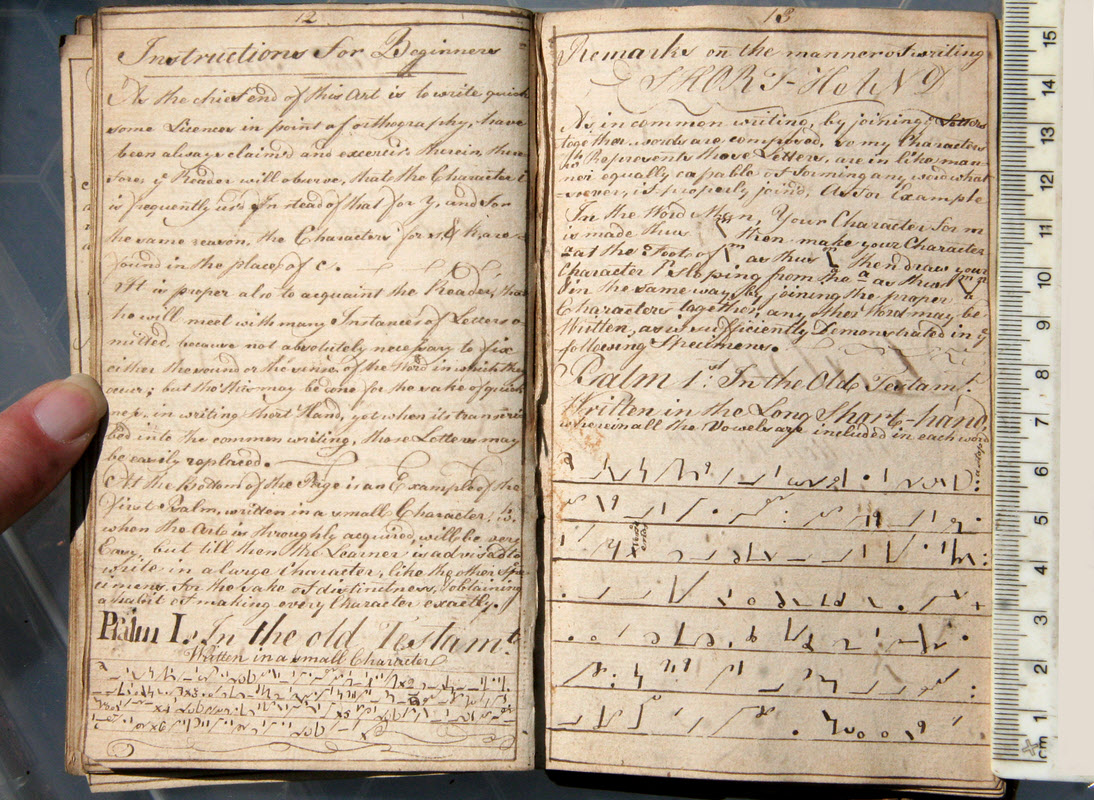
Welcome! This is a "detail" page about a book purchased as part of a job lot at an auction of general household "stuff". There is an overview of the job lot, if you haven't already seen that. This is about "book b" in that overview.
Forgive me for the moment any overlap between this page and the main page... I am (14 July 2013) in the midst of editing.... Please pester me if that date gets more than three days behind "today"... email contact info at bottom"...
Book "b": This is an explanation of shorthand, written out... beautifully... by hand. Note the scale of the handwriting from the photo. And that with a dip pen.
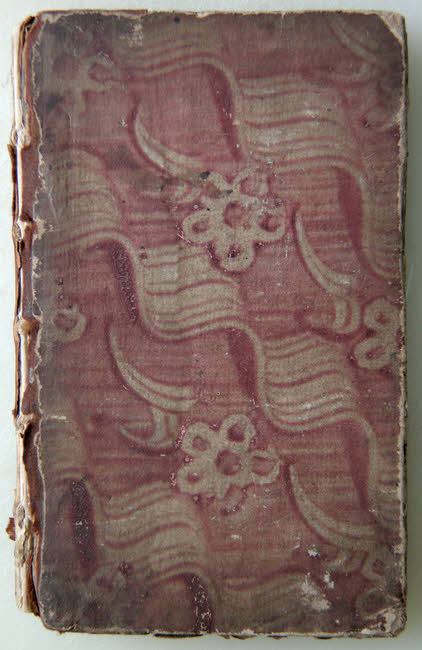
The front board. I believe the effect was created by applying a "paint", and while it was still wet, drawing a narrow comb through it, and pressing a stamp against it. (In case anyone is reading this for reasons other than I have anticipated, perhaps I should just mention that I airbrushed that to remove a distracting mark.)
There is what I take to be an owner's inscription: "Geo. Haworth, 1773". A further inscription on the same page (image to come) says, in different handwriting, "J. Cash to George Haworth of Rochdale" (possibly "Rachdale") That is followed by a date... which isn't written clearly. The day and month are unclear, and the year is confusing too. It, to my eye, looks like it is probably 1839... but it could be 1639. If 1839, why does it speak of "to George Haworth in 1839 when it has what looks like an owner's inscription, George Haworth, dated 1773 at the top of the page? And 1639, doesn't make sense, as the presumed author died in 1788.
Anyway, there was a George Haworth in the Rochdale area...
From http://erwinbagpiper.com/hayworth_family.htm, we learn "James Haworth... born in 1642... lived at Rockcliffe near Bacup in Lancashire, England... James Haworth married Isabel and they had six children... and George. George Haworth... born in 1682 in Rockcliff, Rochdale Parish, Lancashire, England. George emigrated to William Penn's colony in 1699." (where he spent his life).
My guess? That there was another George, brother or cousin of the George who went to Pennsylvania... see below. Of course any of these Rochdale Georges could be unrelated, and none has to be the one time owner of the book! But these Haworth's were in Rochdale parish, Macaulay was from Manchester... about 10 miles away.
At http://nationalarchives.gov.uk there is a will of a George Haworth, Cotton Spinner of Rochdale, Lancs; died January 1850.
Another tid-bit: In a newspaper article from 15 Apr 1850 (http://trove.nla.gov.au/ndp/del/article/4768788) it is alleged that some "George Haworth contrived to absorb some £30,000 of the property of the depositors in the Rochdale Savings bank for his own private benefit". (Maybe he kept his records in shorthand, so that others could not read them!). At http://www.ucd.ie/economics/research/papers/2003/WP03.16.pdf? we find "On the death of George Haworth, actuary of the Rochdale Savings Bank, in November 1849 it was discovered that he had defrauded depositors of over £70,000 ..."
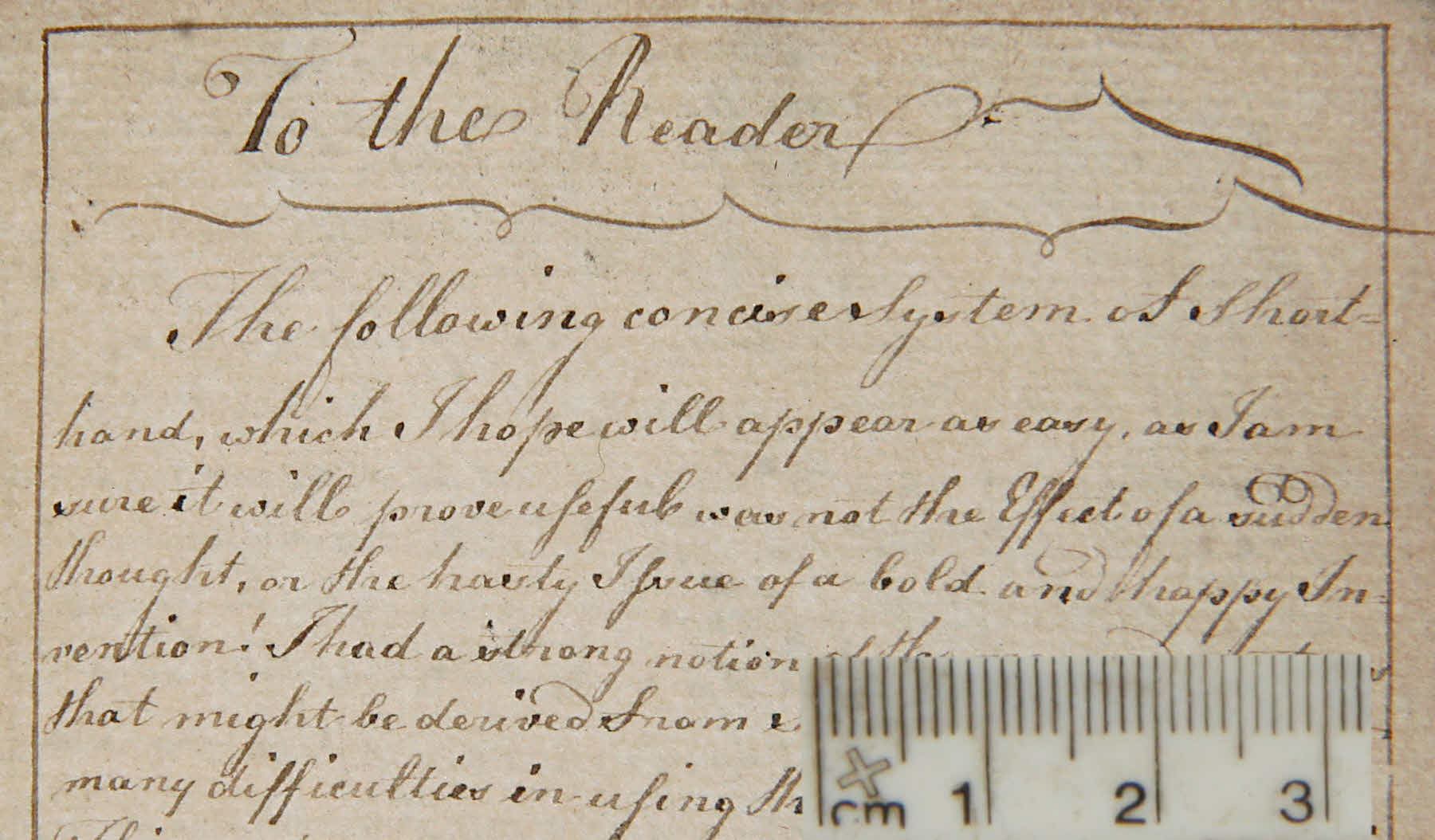
At the bottom of the introduction there's a florid italic rendering... the author's, I take it. What do you think it says?
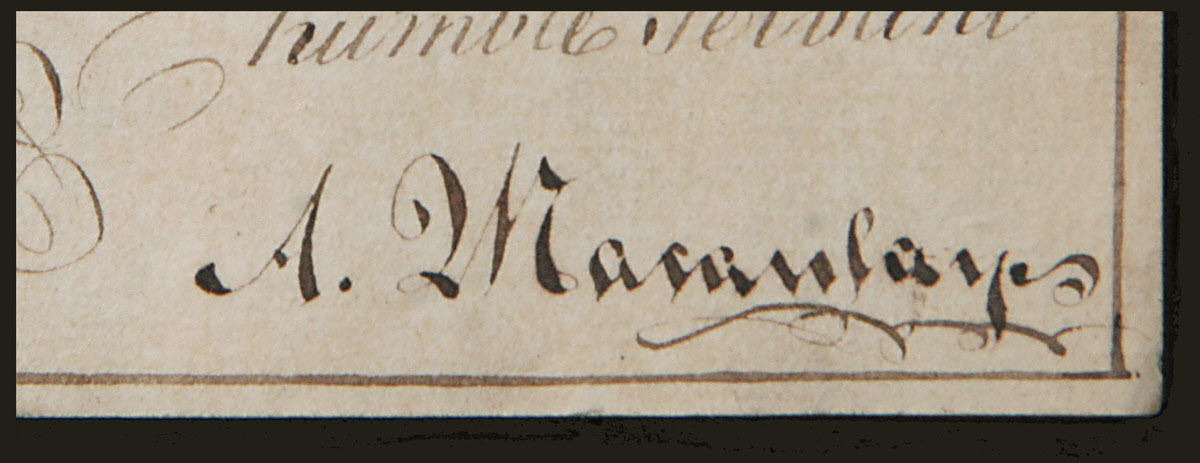
STOP PRESS! Oh my! On 12 Jul 13, 9:10 when I was starting my description of this book, I had just experienced "one of those moments". Thank you Google, thank you Wikipedia.
To which, 13 Jul 13, 09:25, I added: Thank you Abebooks, thank you antiquarian book dealers, and thank you Royal Mail. (I explain these comments later.)
Make your mind up about what the name is, unless it is too late, and you've read further, and have seen what I now think it is. I'll come back to "who wrote it" in a moment.

In the book there is a great deal of sample shorthand for the student. There are also two double page spreads entitled "The Whole Art In One View". The second one has an additional line above that, saying "The New Short Hand"
Have you made your mind up as to the author's name? Originally, my best guess was "Mannlay". Yes, odd, but best I could do. I'd written the text to invite you to email me with thoughts on what it might say. While working on this page, I looked at the image again, and this time wondered if the name was "Mac"-something. I put Macaulay into Google, got many hits, of course. Then tried Macaulay stenography, and got a Wikipedia article. From that, and yes, it was written before this!... "Aulay Macaulay was an 18th-century English tea-dealer, based in Manchester, who invented a system of shorthand which could be used in English and many other languages. He died on 19 March 1788, in Manchester."
At the end of the main page, I've made a guess as to the combined age of all of the books I picked up in my auction lot. That still seems about right, even after pinning down who wrote (in both senses of the word!) this little book.
But my guess at what they would have been worth, if they'd been in even "good" condition didn't ascribe any value to this item, as it was such an imponderable. It still doesn't... for the same reason.
Going into any auction, I decide ahead of time the maximum I will bid on any lot. The the auction catalogue's description... "Captain Cook's Voyages, one leather bound volume (poor condition); Geography for Children, one volume, leather bound, 1802 (poor condition); a Christian Prayer Book in Arabic, early 18th century and other interesting old leather bound volumes (all poor condition)"... headlined the Cook... which is grubby, paper "going", frontis and title page missing, and a few pages at the end missing. But an edition not currently listed at Abebooks. It didn't interest me, given it's condition and lacunae. I'd seen and was interested in the Locke. However, neither the auctioneer nor I had put much value on this little gem! (I "liked" it, as a curiosity, as a "treasure" of one person's hard work and lovely handwriting... but nothing more.) But I am guessing that the £180 I paid for the eleven books, even in the condition they are in, may prove to be okay, even if the "pleasure they give me" factor is excluded!)
While neither Abebooks nor Wikipedia are, I know, the ultimate authorities in their fields, they are very accessible, and have a degree of use. At Abebooks at the moment, there are a couple copies of a printed book on his stenographic system by Macaulay, in fair condition, at about £200. (The first edition was 1747, and there was at least a third edition.) And it is available in a modern print on demand. Macaulay may not have been a Pitman, but neither, it seems, did his idea go no further than the author's manuscript that I now own, thanks to the auction lot.
Remember I said, "Thank you Abebooks, thank you antiquarian book dealers, and thank you Royal Mail"? Here's the explanation....
Not only, the day before I wrote this paragraph, was Abebooks.co.uk (or .com) telling me that Macaulay had published a book about his method of shorthand, but Abebooks.co.uk was also telling me that there were two first edition copies of Macaulay's book available, and a third edition copy at a quite sensible price. (With, alas, a deteriorated binding.) I ordered it.... about noon, as I recall. Friday. Nine thirty, Saturday morning, it arrived at my home! So: Thank you Abebooks for letting me scour the world in minutes, bookseller for processing my order remarkably quickly, and getting the parcel in the post quickly, and Royal Mail for collecting the parcel in Surrey, moving it to Sussex, and getting it into the deliveryman's bag this morning.
And, if you have been paying attention, you will be wondering what I was wondering quite fervently: How does the printed version of Mr Macaulay's exposition of his system compare with the manuscript copy I have....
I'm delighted to tell you that the two are certainly very similar. The text in the printed book on the "To the Reader...." page (the manuscript of the same is shown above) is the same in the two books, for instance. I haven't done an obsessive page-by-page comparison... but I've checked quite a few elements of the two.
Oh no! As I was typing that, an alternative explanation occurred to me! (And alternative to the theory that I have the author's manuscript.) Perhaps I have a copy of the book, made by someone who didn't want to pay for a printed copy? This, I am told by people who know more about these things than I do (and by common sense) was not uncommon in the period... especially for a textbook, like my Macaulay.
At one point, I said "On refection, I suspect the former." I fear that on further reflection, I have to say, "I hope the former". Sigh.
One flaw with the "author's manuscript" theory is that the signature doesn't really "look right". Who signs in italic? And surviving examples of Macaulay's signature don't have a lot in common with the rendering of his name in my copy. Oh well... it was a good story! And even if it is only a copy, it is a fun thing to see.
Below you see the end of Genesis Chapter 40, in the manuscript and in the printed version. I'd hoped to see a clear match in "handwriting", but you have to remember that whoever wrote each was working in rather different media. Furthermore, the printed version may have come from the "pen" of an engraver who had learned the shorthand in order to undertake the project, rather than from Macaulay himself.
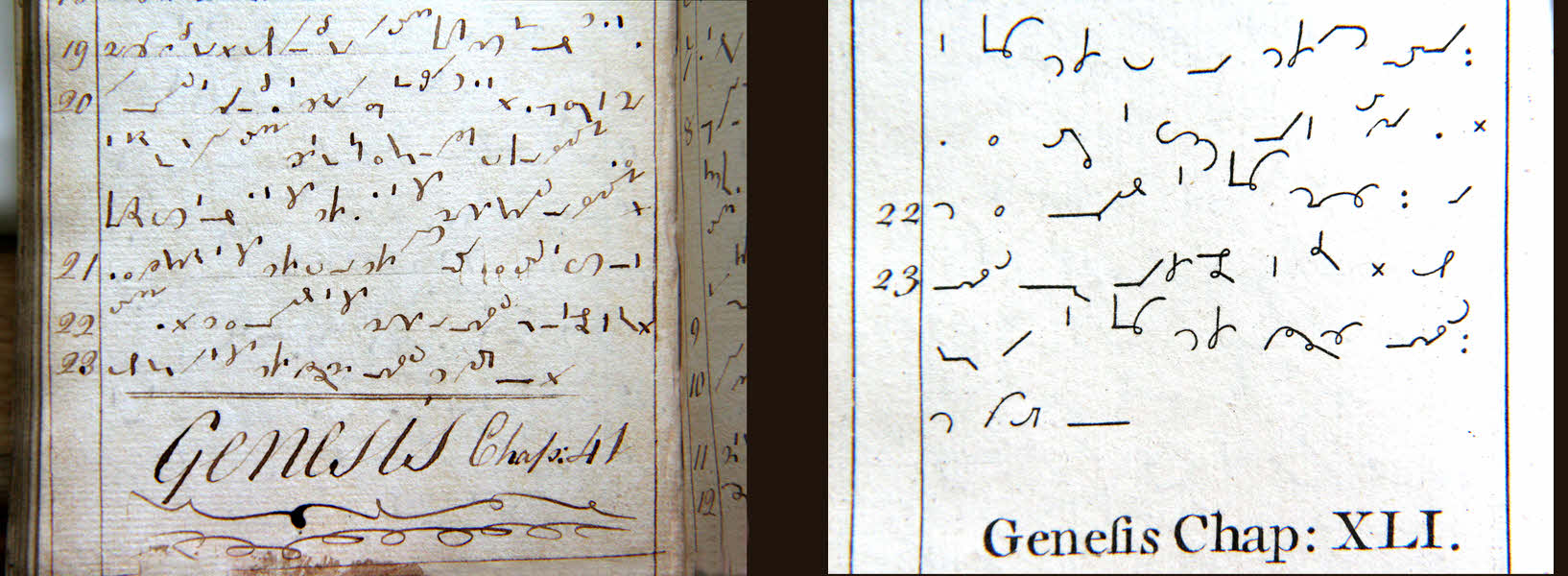
For a start, to copy Macaulay's book, you would not only have to be able to write well... a less common skill before 1773, if you accept the owner's inscription as truthfully dated. You would also have had to be fluent in both the old shorthand (of which Macaulay gives several examples) and in his new shorthand.
I haven't checked every page yet, but preliminary indications are good. In the third edition of the book, at least, Macaulay wrote out a bit of a Psalm in eight languages, to show that his system is suitable not only for English, but for any language. Sadly, the samples of other languages are not present in the manuscript I have. (I wonder if they appeared in the first edition?) Oh well.)
In the printed copy, in both the first and third editions, starting at page 75 (in both cases), Macaulay gives us a bit of Psalm CXVII in Welsh, Dutch, French, Spanish, Italian, Latin, Greek, and Hebrew. (If I get access to a time machine, I want to go back and trail around with Macaulay as he scours Manchester looking for people to read him the psalm in sundry languages!)
Both the first and third editions end on page 119, a page like many others, but with a small "Finis" at the bottom of it, outside the margin around the page of sample shorthand. The first and third editions also have similar material at the following pages, picked at random: 1, 4, 8, 28, 60, 94, 108. This is not so very remarkable, given that every page was done with an engraved plate, not with moveable type. The pages before "Page 1" in the first edition go up to "number" VIII (which looks to be the same plate as used for...) and "number" XXVI in the third edition. (Many of the extra pages are taken up with a rendering of Psalm XV in shorthand.) (I was comparing my third edition with the first edition at the British Library, available online via Archive.org. (Link: below))
There are ebooks online, if you want to look into this further...e.g. at Archive.org
That's the detail on this book. If you enjoyed it, you may want to go "up" to the page about the "job lot" of books it came from, at an ordinary "furniture/ jewelry/ art" auction with only about 5 lots of books out of about 350.
Editor's email address for comments or questions.
![]() Page tested for compliance with INDUSTRY (not MS-only) standards, using the free, publicly accessible validator at validator.w3.org. Mostly passes. There were two "unknown attributes" in Google+ button code. Sigh.
Page tested for compliance with INDUSTRY (not MS-only) standards, using the free, publicly accessible validator at validator.w3.org. Mostly passes. There were two "unknown attributes" in Google+ button code. Sigh.
....... P a g e . . . E n d s .....